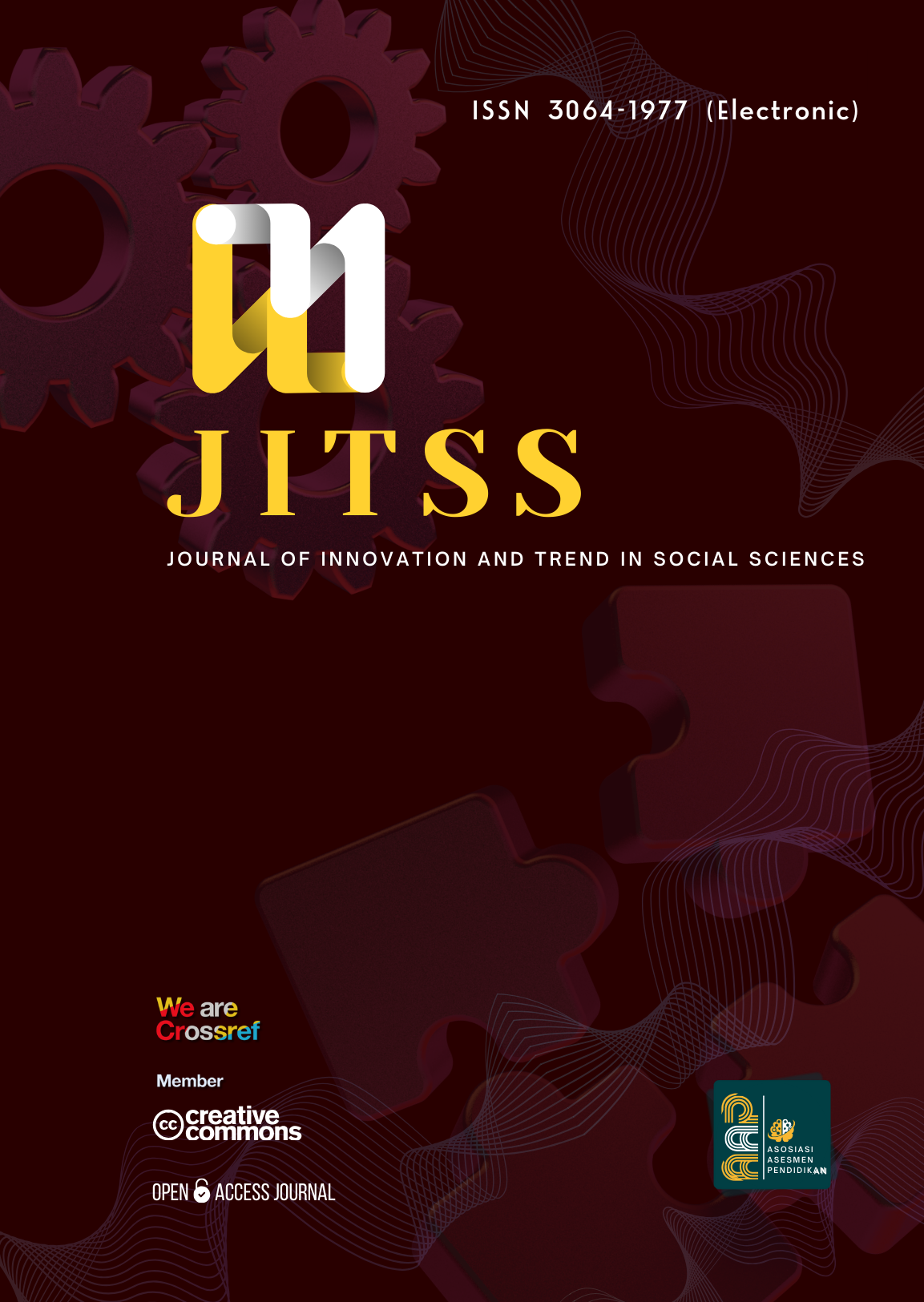Predicting Learning Anxiety Through Adversity Quotient
-
Published: August 25, 2024
-
Page: 29-39
Abstract
The aim of this study is to determine whether there is an effect of adversity quotient on learning anxiety and to describe the adversity quotient and learning anxiety of students. This research employs a quantitative approach. The population and sample of this study are all 227 students of the 11th-grade at SMA Budhi Warman 1 East Jakarta. Data on adversity quotient and learning anxiety were collected through two questionnaires, the adversity quotient instrument developed from Paul G. Stoltz's theory (2005) consisting of 23 items, and the learning anxiety instrument developed from Allen J. Ottens’s theory (1991) consisting of 21 items. The data were analyzed using SPSS software with a linear regression technique. The findings of this study indicate a significant effect of adversity quotient (X) on learning anxiety (Y), with the adversity quotient contributing 30.2% to learning anxiety. Additionally, the regression coefficient is negative, indicating that an increase in adversity quotient leads to a decrease in learning anxiety.
- Adversity Quotient
- Learning Anxiety
- Students Academic

This work is licensed under a Creative Commons Attribution 4.0 International License.
- Amalia, C. (2018). Upaya Guru Bimbingan Konseling Dalam Mengatasi Kecemasan Belajar Siswa Di Kelas XI MIA 4 MAN 2 Deli Serdang Tahun Ajaran 2017/2018. Universitas Islam Negeri Sumatera Utara Meddan.
- Armadani, J. P., & Laksmiwati, H. (2022). Hubungan Antara Motivasi Berprestasi Dengan Kecerdasan Adversitas Pada Mahasiswa Yang Bekerja. Jurnal Penelitian Psikologi, 9(7), 14–26.
- De Villiers, R. (2010). The incorporation of soft skills into accounting curricula: preparing accounting graduates for their unpredictable futures. Meditari Accountancy Research, 18(2), 1–22.
- Fatoni, A., Dewi, P., & Triana, N. (2022). Gambaran Tingkat Kecemasan Orang Tua Siswa Terhadap Pelaksanaan Pembelajaran Tatap Muka (Ptm) Pada Era Pandemi Covid-19 Di Sd Negeri 1 Panambangan. Jurnal Cakrawala Ilmiah, 2(1), 157–165.
- Hambali, I., Wahyuni, F., Studi sarjana Keperawatan dan Profesi ners, P., Tinggi Ilmu Kesehatan Kendal, S., & Laut, J. (2022). Tingkat Ansietas Mahasiswa Indonesia Selama Pandemi Covid-19. Jurnal Ilmu Keperawatan Jiwa, 5(1). https://journal.ppnijateng.org/index.php/jikj
- Harahap, I. D., & Pranungsari, D. (2020). Hubungan antara konsep diri dan adversity quotient dengan kecemasan menghadapi masa depan remaja jalanan. Universitas Ahmad Dahlan.
- Huda, T. N., & Mulyana, A. (2017). Pengaruh adversity quotient terhadap prestasi akademik mahasiswa angkatan 2013 fakultas psikologi UIN SGD Bandung. Psympathic: Jurnal Ilmiah Psikologi, 4(1), 115–132.
- Humami, F., Mukhadis, A., & Sumarli, S. (2014). the effect of numbered heads together (NHT) teaching model and adversity quotient on learning achievement subjects of energy conversion machines. Vocational Technology, 37(2), 119–128.
- Mahardika, H. G., Matulessy, A., & Rini, A. P. (2022). Resiliensi Dan Kebersyukuran Terhadap Kecemasan Saat Pembelajaran Tatap Muka (Ptm) Pada Siswa. Repository Fakultas Psikologi Untag Surabaya.
- Martin, A. D. (2009). Emotional Quality Management : Refleksi, Revisi, dan Revitalisasi Hidup Melalui Kekuatan Emosi (2nd ed.). Arga Excellency.
- Mayasari, H., Astuti, I., & Wicaksono, L. (2021). Analisis Kecemasan Siswa Dalam Pembelajaran Daring Pada Kelas Xi Ma Islamiyah Pontianak Tahun 2021. Program Studi Bimbingan Dan Konseling FKIP Untan Pontianak.
- Mukholil. (2018). Kecemasan Dalam Proses Belajar. Jurnal Eksponen, 8(1).
- Mulyani, E., Wahyuningsih, S., & Natalliasari, I. (2019). Adversity Quotient Mahasiswa Pendidikan Matematika dan Keterkaitannya dengan Indeks Prestasi Kumulatif. Mosharafa: Jurnal Pendidikan Matematika, 8(1), 119–130.
- Nurfitri, E. A., & Nastiti, D. (2021). Relationship Between Adversity Quotient And Answering Between The Tahfidz Exam At The Santri Pondok Pesantren. Academia Open, 6. https://doi.org/10.21070/acopen.6.2022.1638
- Rachmady, T. M. N., & Aprilia, E. D. (2018). Hubungan adversity quotient dengan kecemasan menghadapi dunia kerja pada freshgraduate Universitas Syiah Kuala. Journal Psikogenesis, 6(1), 54–60.
- Rinawati, S., & Hartono, H. (2019). The Analysis of Studentâ€TM s Problem Solving Difficulty Viewed From Adversity Quotient on Means-Ends Analysis Learning. Unnes Journal of Mathematics Education Research, 8(2), 165–172.
- Safitri, A. N., & Juniati, D. (2018). Students’ Relational Understanding in Quadrilateral Problem Solving Based on Adversity Quotient. Journal of Physics: Conference Series, 947(1), 12039.
- Setyawati, M. (2017). Daya juang menghadapi diskriminasi kerja pada penyandang tunadaksa. Psikoborneo, 5(1), 56–67.
- Shemaili, N. B. (2013). Correlation between Experiential learning and Optimism among College students. The British University in Dubai.
- Stoltz, P. G. (2005). Adversity Quotient Mengubah Hambatan Menjadi Peluang (Y. Hardiwati (ed.); 6th ed.). PT. Grasindo - Gramedia Widiasarana Indonesia.
- Surya, M. A. (2021). Kontribusi Adversity Quotient Dengan Kecemasan Menghadapi Dunia Kerja Pada Mahasiswa Jurusan Bimbingan Penyuluhan Islam Fakultas Dakwah dan Komunikasi UIN Sumatera Utara.
- Vinas, D. K. D., & Malabanan, M. G. A. (2015). Adversity quotient and coping strategies of college students in Lyceum of the Philippines University. Asia Pacific Journal of Education, Arts and Sciences, 2(3), 68–72.
- Yurtseven, N., & Akpur, U. (2018). Perfectionism, Anxiety and Procrastination as Predictors of EFL Academic Achievement: A Mixed Methods Study. Novitas-ROYAL (Research on Youth and Language), 12(2), 96–115.
- Zuraida. (2018). Hubungan Adversity Quotient Dengan Prokrastinasi Akademik Dalam Penyelesaian Skripsi Pada Mahasiswa Yang Bekerja Di Pts. Universitas Potensi Utama. Kognisi Jurnal, 2(2), 136–147.












